B-hIL2RB/hIL2RG/hIL15/hIL15RA mice
| Strain Name |
C57BL/6-ll2RBtm2(IL2RB)BcgenIl2RGtm2(IL2RG)BcgenIl15tm1(IL15)Bcgen Il15RAtm1(IL15RA)Bcgen/Bcgen |
Common Name | B-hIL2RB/hIL2RG/hIL15/hIL15RA mice |
| Background | C57BL/6 | Catalog number | 111866 |
|
Aliases |
IL2RB: CD122, IL15RB, IMD63, P70-75 IL2RG: CD132, CIDX, IL2RG, IMD4, P64, SCIDX, SCIDX1 IL15RA: CD215 |
||
Protein expression analysis- IL2RB

Strain specific IL2RB and IL2RG expression analysis in homozygous B-hIL2RB/hIL2RG/hIL15/hIL15RA mice by flow cytometry. Splenocytes were collected from wild-type mice and B-hIL2RB/hIL2RG/hIL15/hIL15RA mice that treated with anti-mCD3ε in vivo, and analyzed by flow cytometry with species-specific antibody. Human IL2RB were detectable in T cells and NK cells of homozygous B-hIL2RB/hIL2RG/hIL15/hIL15RA mice.

Strain specific IL2RB and IL2RG expression analysis in homozygous B-hIL2RB/hIL2RG/hIL15/hIL15RA mice by flow cytometry. Splenocytes were collected from wild-type mice and B-hIL2RB/hIL2RG/hIL15/hIL15RA mice that treated with anti-mCD3ε in vivo, and analyzed by flow cytometry with species-specific antibody. Human IL2RG were detectable in T cells and NK cells of homozygous B-hIL2RB/hIL2RG/hIL15/hIL15RA mice.

IL2RB and IL2RG expression analysis in human PBMC by flow cytometry. Human IL2RB and IL2RG were detectable in T cells and NK cells.
IL2RB and IL2RG expression in humanization mice were consist with human PBMC.
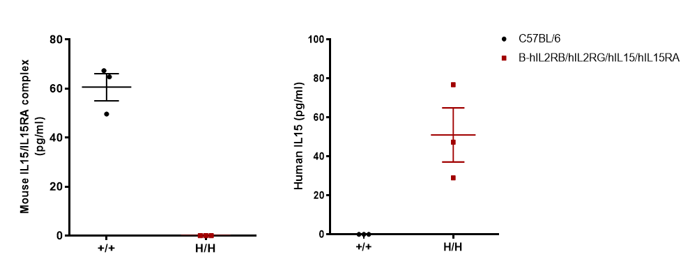
Protein expression analysis. Human IL15 was detectable in serum of homozygous B-hIL2RB/hIL2RG/hIL15/hIL15RA mice.
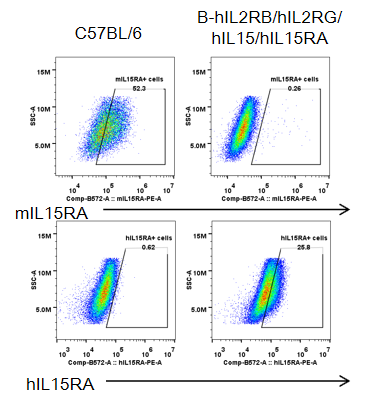
Protein expression analysis. Human IL15RA was detectable in BMDCs of homozygous B-hIL2RB/hIL2RG/hIL15/hIL15RA mice.

Analysis of spleen leukocyte subpopulations by FACS. Splenocytes were isolated from female C57BL/6 and B-hIL2RB/hIL2RG/hIL15/hIL15RA mice (n=3, 7-week-old). Flow cytometry analysis of the splenocytes were performed to assess leukocyte subpopulations. A. Representative FACS plots. Single live cells were gated for the CD45+ population and used for further analysis as indicated here. B. Results of FACS analysis. Percent of T cells, B cells, NK cells, CD4+ T cells and CD8+ T cells in homozygous B-hIL2RB/hIL2RG/hIL15/hIL15RA mice were similar to those in the C57BL/6 mice. The same results were observed in blood and lymph node. Values are expressed as mean ± SEM.

Analysis of T cell subpopulations by FACS. Splenocytes were isolated from female C57BL/6 and B-hIL2RB/hIL2RG/hIL15/hIL15RA mice (n=3, 7-week-old). The proportion of T cells subpopulation was tested by flow cytometry. A. Representative FACS plots. Single live cells were gated for the CD3+ population and used for further analysis as indicated here. B. Results of FACS analysis. Percent of CD4+ T cells, CD8+ T cells and Tregs in homozygous B-hIL2RB/hIL2RG/hIL15/hIL15RA mice were similar to those in the C57BL/6 mice. The same results were observed in blood and lymph node. Values are expressed as mean ± SEM.
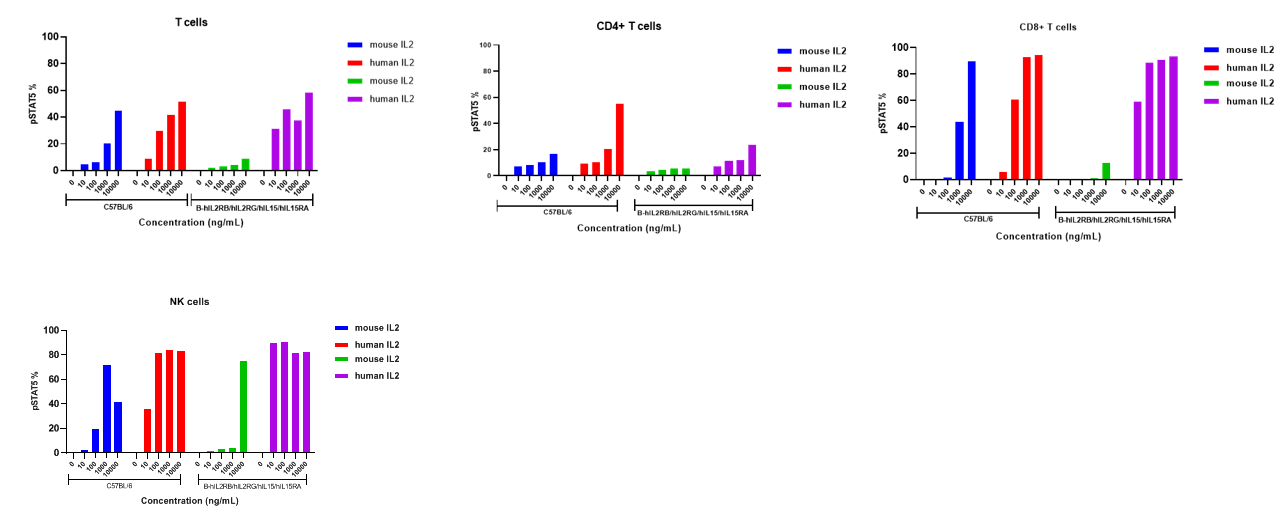
Intracellular phosphorylation of pSTAT5 analysis in splenocytes by flow cytometry. Splenocytes were harvested and analyzed for pSTAT5 induction in the indicated cell types. IL2 induced pSTAT5 in T cells in a dose dependent. Specifically induced high level of pSTAT5 in CD8+T cells and NK cells. At the same concentration, human IL2 induced higher pSTAT5 in humanized mice than that in wild type C57BL/6 mice, which means humanized B-hIL2RB/hIL2RG/hIL15/hIL15RA mice was more sensitive to human IL2.

Intracellular phosphorylation of pSTAT5 analysis in splenocytes by flow cytometry. Splenocytes were harvested and analyzed for pSTAT5 induction in the indicated cell types. IL15/IL15RA complex induced pSTAT5 in T cells in a dose dependent. Specifically induced a high level of pSTAT5 in CD8+T cells, no efficiency in CD4+ T cells. In addition, mouse IL15/IL15RA induced lower pSTAT5 in humanized mice compared to human IL15/IL15RA complex at the same concentration.
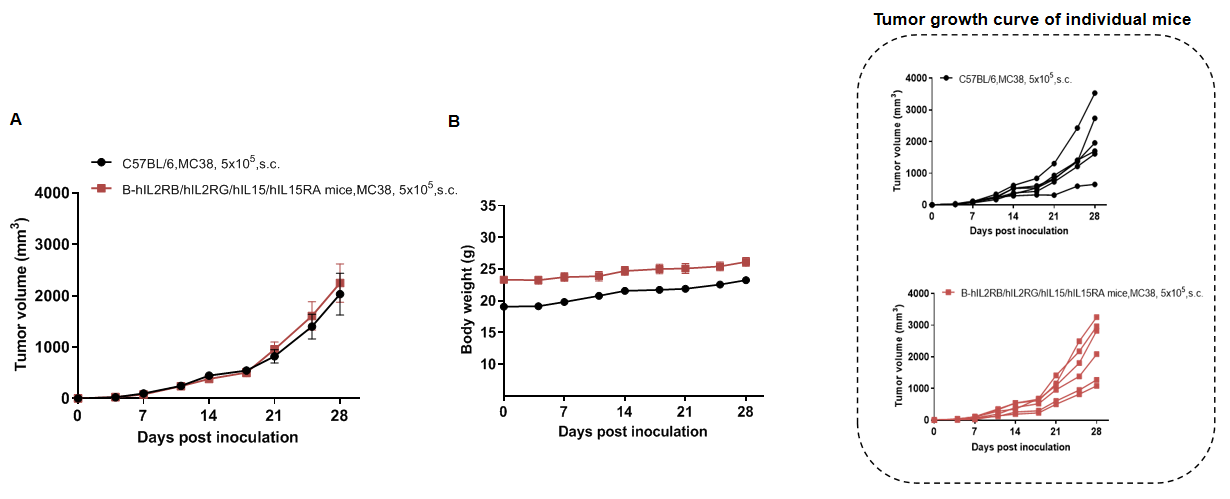
Subcutaneous homograft tumor growth of MC38 cells. MC38 cells (5x105) were subcutaneously implanted into C57BL/6 and B-hIL2RB/hIL2RG/hIL15/hIL15RA mice (female, 9-week-old, n=6). Tumor volume and body weight were measured twice a week. (A) Average tumor volume ± SEM. (B) Body weight (Mean± SEM). Volume was expressed in mm3 using the formula: V=0.5 X long diameter X short diameter2. As shown in panel A, MC38 cells were able to establish tumors in vivo and can be used for efficacy studies.
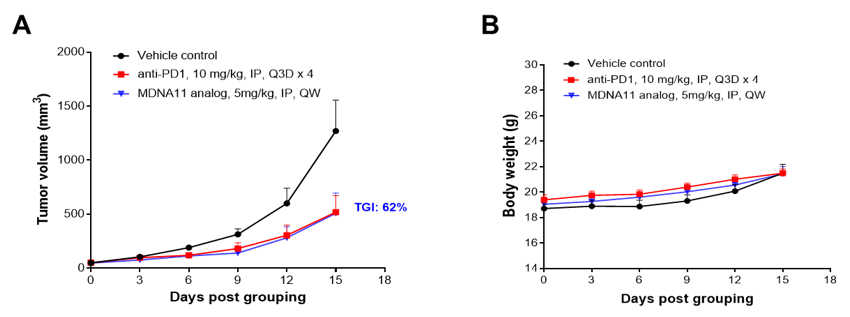
Antitumor activity of a long-acting IL-2 superkine (MDNA11 analog) in B-hIL2RB/hIL2RG/hIL15/hIL15RA mice. MC38 cells were subcutaneously implanted into homozygous mice (female, 6-7 weeks old, n=6). Mice were grouped when tumor volume was approximately 50 mm3, at which time they were treated with drugs in doses and frequency shown in the panel. (A) MC38 tumor growth. (B) Body weight changes during treatment. As shown, MDNA11 analog were efficacious in controlling tumor growth. These mice provide a powerful preclinical model for in vivo evaluation of IL2 therapy molecules. Values are expressed as mean ± SEM.
*The experiment is verified by the cooperation partner. The drugs used here all belong to clients.
*MDNA11 analog is not bind to human IL2RA but higher affinity binding to human IL2RB.

Antitumor activity of a long-acting IL-2 superkine (MDNA11 analog) in B-hIL2RB/hIL2RG/hIL15/hIL15RA mice. MC38 cells were subcutaneously implanted into homozygous mice (female, 6-7 weeks old, n=6). As shown, MDNA11 analog were efficacious in controlling tumor growth.
*The experiment is verified by the cooperation partner. The drugs used here all belong to clients.
*MDNA11 analog is not bind to human IL2RA but higher affinity binding to human IL2RB.
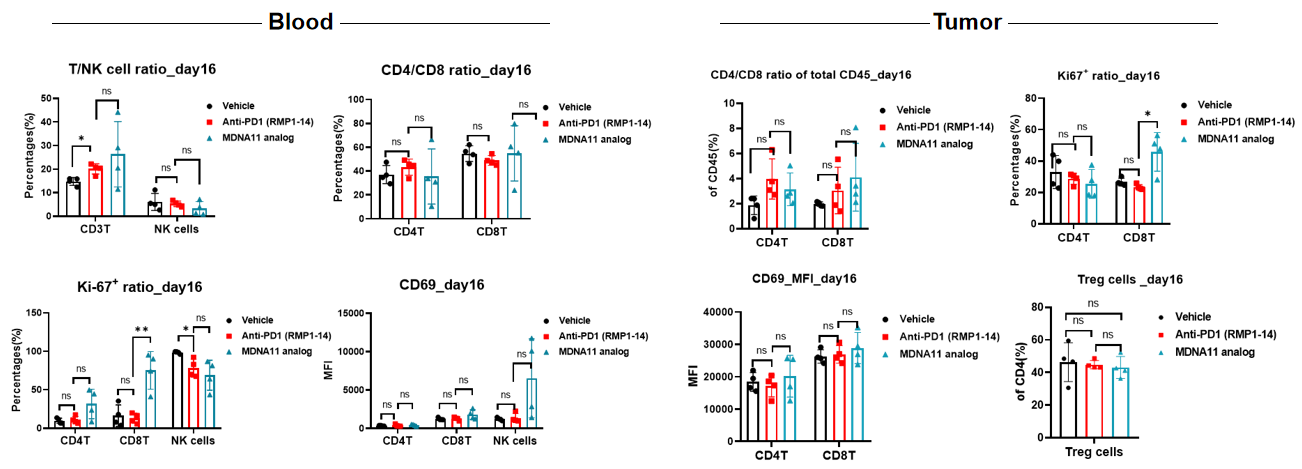
At the endpoint of the experiment, blood and tumor samples were collected and assessed for the activation and proliferation of T and NK cells by flow cytometry.











 京公網安備: 11011502005564號
京公網安備: 11011502005564號